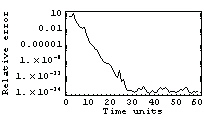|
6.2.1 Reduced-Order State Estimator via Pole Assignment
The design of the reduced-order state estimator via the pole assignment approach adheres to the following template.
1. Find an orthogonal matrix  from the QR decomposition of the output matrix from the QR decomposition of the output matrix  : :  , and then choose an orthogonal matrix , and then choose an orthogonal matrix  such that the matrix such that the matrix  is also orthogonal. is also orthogonal.
2. Compute  and and  and partition them as and partition them as  , where , where  , ,  , ,  , and , and  are, respectively, are, respectively,  , ,  , ,  , and , and  matrices. matrices.
3. Find a matrix  such that such that  is stable. is stable.
4. Find  , an estimate of , an estimate of  , as , as  , where , where  is given by is given by  with with  , ,  , and , and  . .
ReducedOrderEstimator in this approach uses the function StateFeedbackGains to implement step 3. Correspondingly, the function ReducedOrderEstimator takes the options of the function StateFeedbackGains.
These are the estimator poles, chosen at random.
In[14]:=
Out[14]=
This constructs a reduced-order state estimator of the steam power system via pole assignment (using the Schur method) with the randomly chosen poles.
In[15]:=
Out[15]=
This is the estimated state response.
In[16]:=
This graphs the relative error between the true and estimated state responses.
In[17]:=

|


